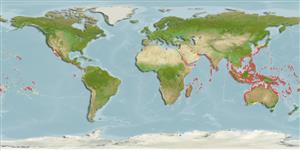Issue
Pempheris flavicycla flavicycla was considered as synonym of P. adusta by Koeda et al., 2014 (Ref. 95675) but valid according to Randall et al., 2014 (Ref.95583); and Pempheris flavicycla marisrubri as synonym of P. erythraea in Golani et al., 2018 Ref. 120578. Please send references, or more studies are needed.
Environment: milieu / climate zone / depth range / distribution range
Ökologie
seewasser riff-verbunden; tiefenbereich 0 - 20 m (Ref. 95675). Subtropical
Indo-Pacific: widely distributed and abundant in the Indian Ocean (including the Red Sea to Andaman Sea) to the Pacific; not in the Mediterranean Sea. Regional variations present in the Indian, Andaman and the Pacific.
Size / Gewicht / Alter
Maturity: Lm ? range ? - ? cm
Max length : 17.0 cm TL Männchen/unbestimmt; (Ref. 6645)
Kurzbeschreibung
Bestimmungsschlüssel | Morphologie | Morphometrie
Rückenflossenstacheln (insgesamt) : 6; Rückenflossenweichstrahlen (insgesamt) : 8 - 10; Afterflossenstacheln: 3; Afterflossenweichstrahlen: 36 - 45; Wirbelzahl: 25. This species is distinguished by the following characters: pectoral fin base with a faint blackish spot; pored lateral-line scales 56-64 (Andaman Sea 52-58; Pacific 51-62); scale rows above lateral line 4.5-6.5 (usually 5.5; Andaman Sea and the Pacific Ocean, 4.5-5.5, usually 4.5); circumpeduncular scales 14-18 (usually 16); outer edge of anal fin with a distinct blackish band (rarely faint or only anterior half prominent; usually none in Pacific); posterior edge of caudal fin with a blackish band (caudal fin whole yellowish in Andaman Sea); upper-jaw length 14.2-15.6% SL; body depth 41.4-45.4% SL. Individuals in the Pacific are distinguished from its congeners by the following set of characters: ctenoid and deciduous scales are thin and semicircular in shape; 51-62 pored lateral-line scales; 4.5-5.5 (usually 4.5) scale rows above lateral line; pectoral fin base with a faint blackish spot; anal fin usually have no blackish outer margin; anal fin base with a dusky band (Ref. 95675).
This fish is common on coral reefs (Ref. 6645); forming aggregations in caves or crevices or under overhangs (Ref. 48636) by day, but a few may at times be seen in the open, close to the shelter of reefs. This species is also observed forming small groups with Myripristis murdjan at 0.5-1 m below the surface. At night, it is known to feed on zooplankton (Ref. 94773). Spawning occur during April to June, and is year-round in Okinawa I. (Koeda et al., in press - in Ref. 95675). Spawning occurred after sunset with individuals larger than 11 cm SL joining the spawning group (Ref. 95675). Flesh is edible (Ref. 12484).
Life cycle and mating behavior
Geschlechtsreife | Fortpflanzung | Ablaichen | Eier | Fecundity | Larven
Koeda, K., T. Yoshino, H. Imai and K. Tachinara, 2014. A review of the genus Pempheris (Perciformes, Pempheridae) of the Red Sea, with description of a new species. Zootaxa 3793(3):301-330. (Ref. 95675)
IUCN Rote Liste Status (Ref. 130435: Version 2024-1)
Bedrohung für Menschen
Harmless
Nutzung durch Menschen
Fischereien: kommerziell; Aquarium: Kommerziell; Köder: usually
Tools
Zusatzinformationen
Download XML
Internet Quellen
Estimates based on models
Preferred temperature (Ref.
123201): 22.7 - 29.2, mean 28.2 °C (based on 3783 cells).
Phylogenetic diversity index (Ref.
82804): PD
50 = 0.5000 [Uniqueness, from 0.5 = low to 2.0 = high].
Bayesian length-weight: a=0.01288 (0.00704 - 0.02359), b=3.03 (2.87 - 3.19), in cm total length, based on LWR estimates for this species & Genus-body shape (Ref.
93245).
Trophic level (Ref.
69278): 3.5 ±0.5 se; based on size and trophs of closest relatives
Widerstandsfähigkeit (Ref.
120179): hoch, Verdopplung der Population dauert weniger als 15 Monate. (Preliminary K or Fecundity.).
Fishing Vulnerability (Ref.
59153): Low vulnerability (10 of 100).
Nutrients (Ref.
124155): Calcium = 57.2 [25.1, 110.7] mg/100g; Iron = 0.691 [0.388, 1.225] mg/100g; Protein = 19.2 [18.0, 20.4] %; Omega3 = 0.166 [0.092, 0.296] g/100g; Selenium = 11.5 [5.3, 23.9] μg/100g; VitaminA = 44.3 [11.2, 169.7] μg/100g; Zinc = 0.967 [0.600, 1.510] mg/100g (wet weight);
